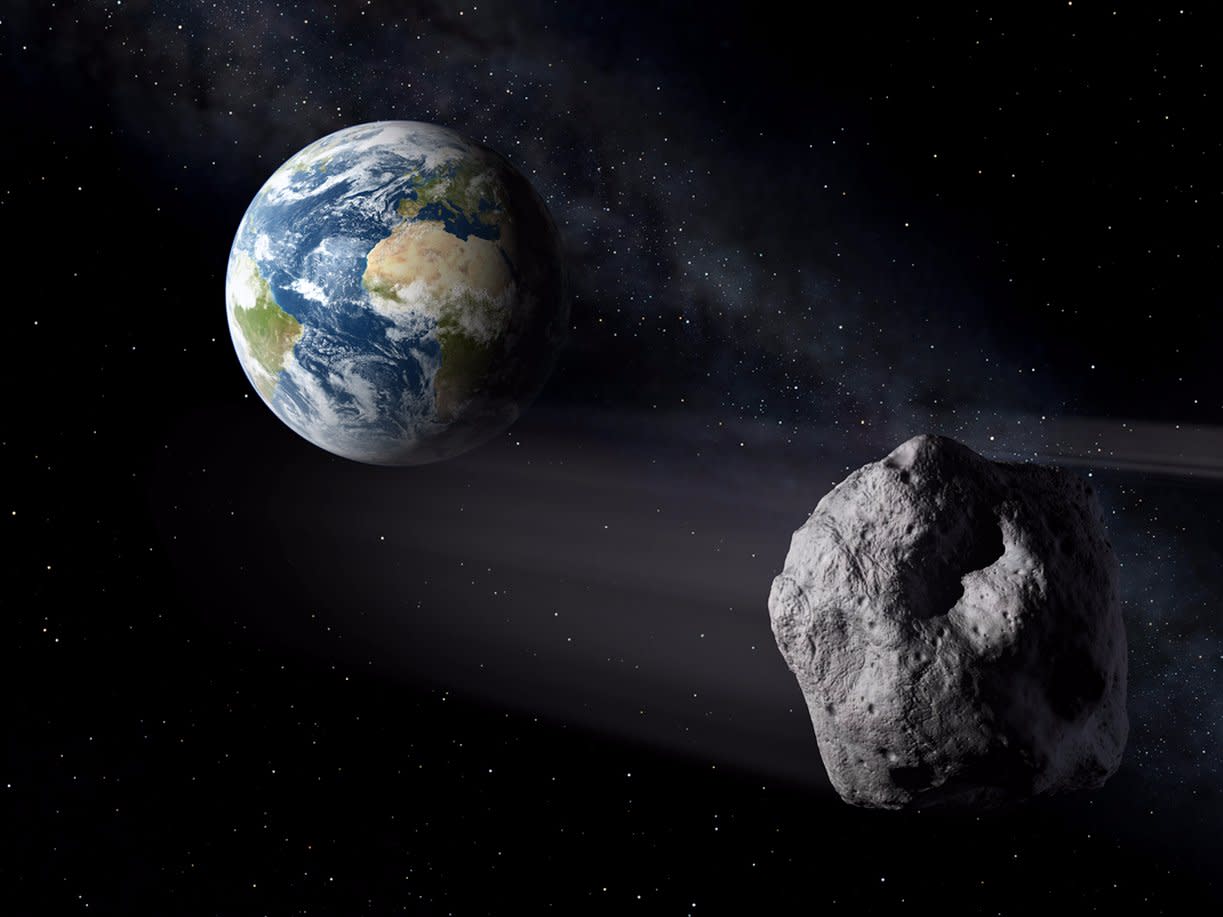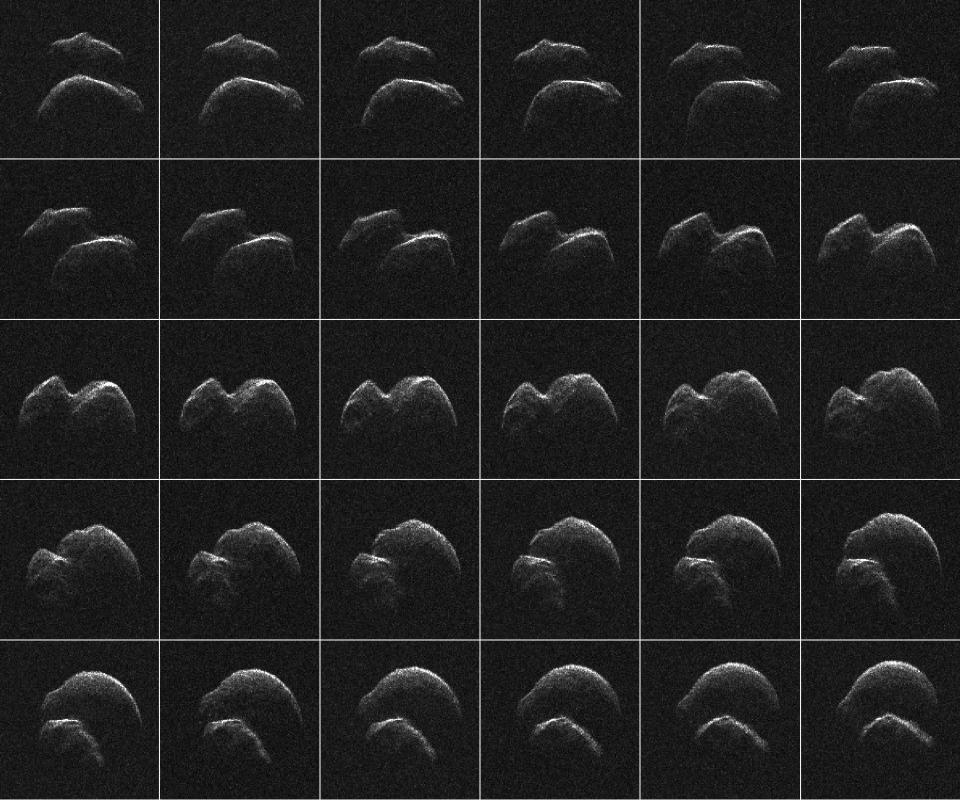NASA just filmed a 'potentially hazardous' asteroid flying near Earth, and it may be 2 times bigger than thought

NASA
Astronomers are taking radar images of a "potentially hazardous asteroid" named 2014 JO25.
The space rock looks like a peanut and may be twice as big as some of the tallest skyscrapers on Earth.
It will safely fly past Earth on Wednesday, April 19.
NASA recently turned down an asteroid-hunting telescope program to find objects like 2014 JO25.
Astronomers on Wednesday night will be keeping a close eye on a big asteroid that's zooming past Earth.
Telescopes like the Arecibo Observatory — a huge radio dish built inside of a Puerto Rican sinkhole — have already started filming the tumbling space rock, called 2014 JO25, by pinging it with radar and recording the echoes.
Below is one of the first radar videos (made by Arecibo) that astronomers took of the asteroid, on April 17.
NASA said the space rock will fly within about 1.1 million miles of Earth, or roughly 4.6 times the distance from our planet to the moon, on April 19.
What we know about asteroid 2014 JO25

NASA/JPL-Caltech/GSSRAstronomers discovered the object about 3 years ago.
Because it will fly so close to Earth, it has earned the label of a "potentially hazardous asteroid," or PHA. However, NASA says 2014 JO25 "will fy safely past Earth" and isn't due to swing by again for more than 400 years.
The rock is estimated to be about 2,030 feet across, NASA said in an April 6 press release. That's roughly between the height of the One World Trade Center in New York City and Shanghai Tower in China — two of the tallest skyscrapers on Earth.
But Edgard Rivera-Valentín, a planetary scientist with the Universities Space Research Association who studies Arecibo data, said it may actually be much larger than that.
"Arecibo revealed that this object ... is twice as big as originally estimated and is shaped like a peanut," Rivera-Valentín told Business Insider in an email, adding that Arecibo and other radar observatories will take their best photos on Wednesday night.
"[A] little bit more time is needed to clearly get at the size of the object" and analyze that data, he said.
NASA's Deep Space Network antenna at Goldstone, California, also recorded the asteroid on April 18. The 230-foot-wide dish photographed the 30 radar images of the space rock (above) as it hurled toward the vicinity of Earth from about 1.9 million miles away.
Astronomers turned those images into a sped-up movie:
Defending Earth by 'pinging' asteroids

Uploaded to Wikipedia by File Upload Bot (Magnus Manske)
The rock's "peanut" shape comes from the fact that it's a "contact binary," the term for when two rocks smoosh together in space.
Rivera-Valentín previously told Business Insider that contact binaries make up about one in every six space rocks, which makes them very common leftovers of our solar system's formation.
Rivera-Valentín said it's vital to make movies of these near-Earth objects (NEOs) as they coast through our neighborhood, since there's always a good degree of uncertainty about their future paths — at least after optical telescopes first spot them.
"Arecibo goes beyond acting as a fortune teller, we can characterize these objects," he previously said. "We can study their size, shape, spin state, composition, and near-surface geology."
The ultimate goal is to feed such data into advanced simulations and estimate just how big of a threat a particular hazardous space rock poses to humanity.
"An asteroid impact, unlike other natural catastrophes, can actually be avoided. The data from Arecibo can be used by NASA to inform a planetary defense mission," he said.
A "planetary defense" mission may sound like the plot of a science fiction blockbuster, but NASA is deadly serious about tracking and preparing for killer asteroids. The space agency even has a mandate from Congress to find 90% of an estimated 300,000 NEOs big enough to wipe a large city off the map.
Space rocks that are capable of such devastation pass by us with worrisome frequency. In fact, the typical American is about 30 times more likely to die from a regional asteroid strike during their lifetimes than a refugee terrorist attack, according to a recent data analysis by Business Insider.
However, NASA recently and for a third time turned down NEOCam — a powerful asteroid-hunting space telescope — that could help get the job done.
In an email to Business Insider, NASA officials said they intend to fund the NEOCam mission, though only partially through 2017 — presumably long enough to track down full funding for the mission, and a rocket on which to launch it.
"The NEOCAM project is working to identify activities that could be done this year that would reduce the technical, schedule, and cost risk of a future mission," David Schurr, the deputy director of NASA's planetary science program, previously told Business Insider.
See Also:

 Yahoo News
Yahoo News 
